How to update an old cast iron bathtub: an overview of restoration and repair work
Cast iron bathtubs seem “eternal” to many. In a sense, this is indeed true.These products are durable, do not corrode and can be used for decades. The only “weak link” is the enamel, which, even with proper care, becomes thinner over time.
Thrifty owners, realizing that only the appearance has deteriorated, are looking for ways to update an old cast-iron bathtub. Let's look at a few of them.
The content of the article:
Is it worth restoring an old bathtub?
We usually send our used products to a landfill without regret. However, a cast-iron bathtub that has lost its attractive appearance may well continue to be used. But replacing it may seem irrational.
The large weight of the equipment makes it very difficult to dismantle and remove it from the apartment, especially if it is located above the first floor. In addition, if tiles have been laid around the bathtub or ceramic screen, all this will have to be disassembled.
The owner understands that simply removing the device will not work; repairs will be required. Big or small - it all depends on the degree of impending destruction. In addition, there will be costs for the purchase of new equipment, its transportation and installation.
Thus, it will not be possible to avoid serious financial losses. You must understand that all this is very troublesome and will require a loss of time.
Perhaps you should save your nerves and money by taking on the restoration of an old bathtub. There are three fundamentally different methods for restoring plumbing fixtures: installing an acrylic liner, cold enameling, and the pour-in method or “pour-in bath.” Each of them has advantages and disadvantages. Let's take a closer look at all restoration methods.
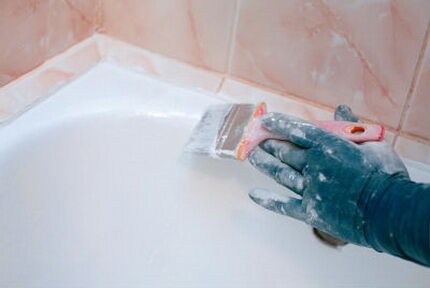
Installing an acrylic liner
This method involves installing an acrylic liner into a cast iron bathtub. As a result, the owner actually receives a new acrylic bowl, the frame for which is old cast iron equipment. The liner is tightly inserted into the bathtub and fixed with a special adhesive mass. After this, a new harness is installed and the device can be operated.
This method has many advantages:
- A bathtub with a liner successfully combines the positive properties of cast iron and acrylic equipment.
- Acrylic has low thermal conductivity, as a result of which warm water takes a very long time to cool down.
- The material of the liner is quite resistant to mechanical damage; small scratches that appear can be easily removed by polishing.
- Acrylic is easy to care for, does not absorb rust and dirt, and does not darken. For cleaning, special products or soap solutions are used.
- The service life of the liner is about 15 years.
The disadvantages of this method include the small range of commercially produced liners. There are only four types: for bowls 170 and 150 cm long, elliptical and rectangular.
In addition, in some cases, for example, if the sides of the bathtub are covered with ceramic tiles, additional work may be necessary.
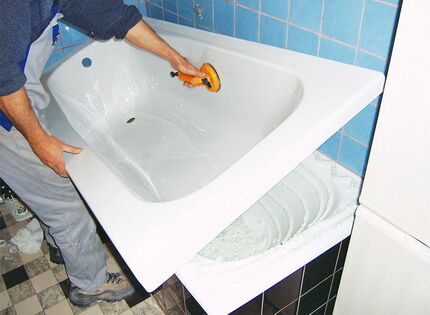
How to choose the right acrylic liner?
Products are produced by stamping and molding of heated polymer mass.This is a high-tech and quite complex process. Even small deviations from the technology or the use of insufficiently high-quality raw materials do not have a positive effect on the performance characteristics of the liner.
Therefore, when choosing a product, you need to pay special attention to several points.
The first is the color of acrylic. High quality material will have an unnatural bright white and shiny appearance. Plastic made from recycled materials has a grayish tone. Over time it may turn yellow.
The thickness of the liner should be at least 4-5 mm. To correctly determine it, you need to look under the rim at the edge of the bowl. Here the plastic layer remains unchanged, while in other places it may be slightly deformed.
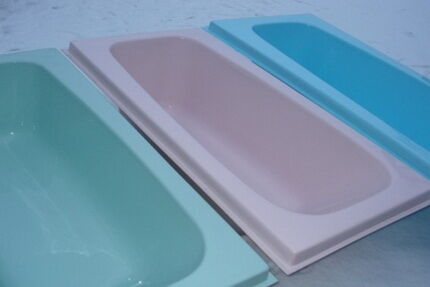
It is also important to evaluate the flexibility and strength of the bowl. Another important point is the selection of the product exactly in size. This task is best handled by a professional measurer who can be invited to your home.
Alternatively, you can take a photo of the casting mark of your bathtub and send it to the manufacturer of the liners, who, based on this information, will be able to select the product as accurately as possible.
Preparing the bowl for updating
The question of how to competently restore an old cast-iron bathtub should begin with finding out how to prepare it for restoration. You need to start by removing contaminants from the surface that prevent adhesion.
To do this, you need to thoroughly wash the bowl from any remaining soap solution and remove lime deposits. After this, use coarse sandpaper to carefully clean the entire surface of the container. Experts recommend paying special attention to the edges of technological holes.Here it is advisable to remove all the enamel at a distance of 3.5-5 cm from the edges.
There should be no traces of rust in these areas. A distance strip needs to be installed around the perimeter of the bathtub. This is necessary so that the sides of the liner fit tightly and do not bend when using the equipment. The thickness of the slats is selected individually.
It needs to be measured with the insert installed for fitting. On average, the height of the element is about 20 mm.
You may have to do some manipulations with the acrylic liner. If there are ceramic tiles on the sides of a cast-iron bathtub, they need to be disassembled. But you can do it differently. The acrylic liner should be trimmed. Even if the cut edge is not aesthetically pleasing enough, it will be covered with a drainage plinth. But the labor costs for installation will be incomparably lower.
Usually the liner is cut with a small gap, about 0.3-0.5 cm from the wall. This is necessary so that the side that bends when using the bathtub does not make unpleasant scraping sounds. To determine the dimensions of the undercut, you need to find out how much longer the side of the liner is than the side of the bathtub.
Trimming is carried out by an amount equal to the size of the side walled into the tile plus half the difference in the width of the liner and the bathtub.
It is also necessary to take into account the curvature of the walls, which can significantly affect the size of the cutout. Therefore, craftsmen recommend taking measurements especially carefully and cutting with a large allowance, with which you can adjust the liner to the required dimensions. To do this, you will need to periodically put the part in place and level the allowance with any abrasive tool.

The next stage is making technological holes in the liner. It needs to be put in place and scratched with an awl, that is, the location of the drain and overflow should be marked on the bowl. They must line up exactly with the holes on the cast iron bowl.
All that remains is to determine the diameters of future holes using a compass and drill them using a crown of the required size. The cut edges are carefully processed with abrasive materials.
Installing and sealing the liner
Before installing the acrylic product, the bathtub bowl must be coated with adhesive. For this purpose, it is recommended to use special mastic, but you can also use regular polyurethane foam.
The latter will not only fix the liner in place, but will also serve as additional insulation for the walls and bottom. When using foam, you need to remember that it expands during the polymerization process.
This may cause unwanted blisters on the surface of the liner. If you use mastics, this will definitely not happen. In addition to these materials, silicone can additionally be used to seal the overflow and drain.
You need to understand that this elastomer is a good sealant, but not the best glue. Therefore, if you use it, you need to apply a fairly large layer of silicone.
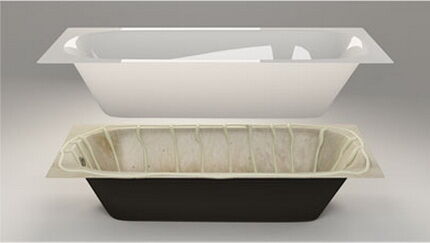
So much so that it forms a circle around the holes with a diameter of at least 15 cm.Otherwise, when dynamic loads appear, the material will begin to peel off, water will begin to seep under the liner, which will lead to the destruction of the foam and the formation of a source of bacterial infection.
The best compositions for gluing the liner include two-component mastics made on the basis of epoxy and elastic high-strength adhesives such as AT-Metal or SikaBond.
Let's take a closer look at the option with polyurethane foam. We start by applying the sealant. It is applied in a wide ring around the technological holes, and retreating from them by 15-20 cm. Immediately after this, the foam is activated. The composition is placed on the bowl in strips from a distance of no more than 25 cm.
First, the foam is placed on the bottom, then on the walls. At the end of the work, the foam should lie in a layer at least 2.5 cm high.
There should be no changes in height or noticeable depressions. On average, this requires a kilogram bottle of foam. Experts advise taking two containers of 750 g each; this amount of material will definitely be enough for the entire bath. In this case, it will be possible to obtain the optimal fit density of the liner and the space under the sides of the product will be well compacted. Immediately after the foam is applied to the cast iron bathtub, a liner is installed into it.
It needs to be pressed firmly. To do this, a cloth is placed at the bottom of the bowl, on top of which a person sits, who with his weight presses the plastic structure to the metal. You should press the sides and walls firmly, and then remove the excess foam that appears. The siphon should be installed on the bathtub as soon as possible. It should be noted that the length of the lag screw taken from old equipment will not be enough.

Therefore, you will have to purchase a new, longer fastener. Then the drain is installed in its place and immediately after that cold water is filled to the brim of the bath. So the equipment should stand for at least a day. It should be taken into account that the sides of the liner may rise slightly, so after 40-45 minutes. after water has been filled into the bath, they need to be carefully pressed down with a flat strip.
If you decide on this type of restoration, we recommend reading the article where we talked in detail about how to properly install acrylic liner.
Cold enamel bath
Another way to restore a cast iron bathtub is cold enameling. This is a fairly simple process that involves applying a special composition to the bowl, which, after hardening, turns into an enamel coating.
The main advantage of the method is its low cost compared to other restoration methods. In addition, the bowl can be coated with such enamel an unlimited number of times.
The disadvantages include long drying of the composition. It will take about 4 days for it to dry completely. In addition, cold-applied enamel is less durable than that used to coat bowls in the factory.
Its service life is a maximum of five years, after which the restoration procedure will have to be repeated. Compared to acrylic, this enamel retains heat less well, so the water in the bath will cool faster.

How to choose the right enamel?
The properties and durability of the future enamel coating directly depend on the quality of the composition.
Experts recommend paying attention to the following points when choosing:
- Method of applying enamel. On sale you can find solutions intended for application by roller, brush or spray. The latter option is especially good because it involves even application.
- Hardener shade. The composition for cold enameling is a two, or less often three, component product. One of the components is a hardener. If it is dark yellow, brown or dark red, an undesirable tint may appear on the finished coating.
- Enamel tone. If desired, the enamel composition can be painted in any color. Special tinting pastes are designed for this, which can be sold complete with enamel or separately. Experts advise choosing the shade of the coating directly in the room where the equipment is installed.
- Restoration kit contents. The fuller it is, the better. Along with the enamel, tinting pastes and special products for preparing the bathtub for restoration can be sold.
Practice shows that fairly thick two-component compositions, such as Epoxin 51C and Epoxin 51, are best suited for application with a roller or brush. They fill small defects in the base quite well.
The Finnish composition Reaflex 50 or Rust-Oleum Specialty is well suited for working with a spray bottle. Whitest NEWTON spray has proven itself quite well. Read a detailed review of bath restorers Further.
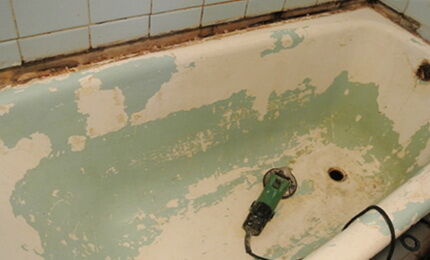
Preparing the bowl for enameling
You should start by removing the top glossy layer of enamel. To do this, the surface will have to be carefully treated with abrasive to remove about 30-50 microns of gloss.For work, you can take sandpaper, abrasive powders or a grinder with a grinding wheel. You can get results especially quickly by using a flap wheel in combination with an abrasive paste. The latter can be prepared independently.
To do this, you need to take grated laundry soap and mix it with abrasive powder for sandblasting in a ratio of 1:3. Craftsmen who know how to restore cast iron bathtubs recommend using ground nickel slag, a fraction no higher than 0.16-0.18 mm.
The components are mixed well and filled with water. The paste is aged for about a day. The result is a viscous mass, reminiscent of fairly hard plasticine.
The entire bowl is treated with it and immediately passed in a petal circle. This is done one or two more times until the base becomes rough and matte. Important note: the enamel should not be completely removed. If the surface begins to noticeably darken, treatment is stopped.
After this, the bowl should be thoroughly washed, the overflow and siphon should be removed, untreated areas should be cleaned and the siphon should be temporarily put in place.
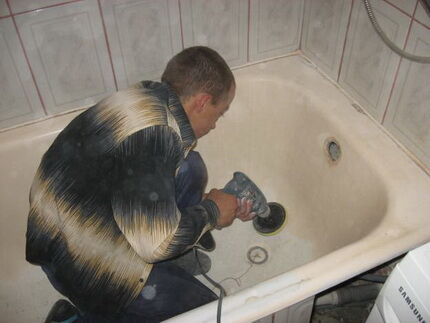
The next step is to degrease the surface, but it is better to carry out chemical etching. It makes the coating structure porous, eliminating deep limestone deposits and rust stains. As a result, the new coating adheres much better and its service life is significantly extended.
If there are stubborn rust stains on the surface, you should start by removing them. They are lubricated with special rust solvents, such as Tsinkar or FAS.
Once the reaction is complete, the stain will blur and turn pale. At this point it needs to be washed off with water.It is important to do this before the solution dries, otherwise the rust will remain in the pores of the coating. Etching is carried out in three steps.
First, a 3.5% hydrochloric acid solution is applied to the surface. This operation is performed several times at intervals of 6-7 minutes. After which the composition is thoroughly washed off and bleach is applied, diluted with water to a paste.
The solution is left on the base for 20 minutes, after which it is washed off. When working with acid and lime, you should wear a respirator; their vapors are poisonous. The surface of the bowl is dried with a hairdryer. After this, degreasing should be carried out to remove all remaining reagents and organic matter. To do this, a lint-free cloth is impregnated with trichlorethylene, Galosh gasoline or acetone. The bowl is carefully processed and then dried.
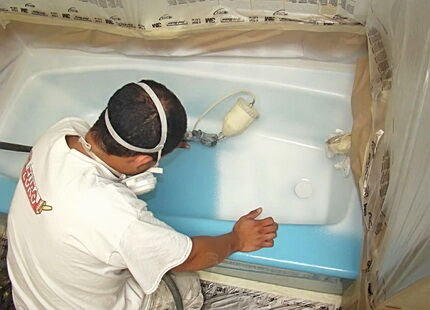
Apply enamel to the bathtub
Immediately before painting, you should wet clean the bathroom. This will get rid of dust that may settle on the surface of the wet enamel. In this case, unpleasant rough spots will appear on the glossy layer, which is extremely undesirable. After this, the door to the bathroom should be kept constantly closed or the opening should be covered with polyethylene.
After this, if necessary, the composition for work is prepared. In this case, all manufacturer's instructions must be strictly followed. The prepared solution is applied to the surface of the bowl. The easiest way to do this is to work with a spray bottle. The paint is sprayed from a distance of about 30 cm. Cross short strokes are made. The solution should slightly moisten the surface.
You don't need to apply a lot of paint. The bowl is covered with several layers of the composition.This needs to be done evenly. The second layer is applied to the first after 15-20 minutes, all subsequent ones are applied at intervals of 30 minutes. After finishing work, the bowl should dry completely. To do this, close the door to the bathroom tightly and enter it only after a day. Painting with a brush is done a little differently.
When painting a bathtub, brush hairs may remain on its surface. They must be removed with a thin needle.
The brush is dipped into the solution, after which several vertical stripes are made with it. They are rubbed with horizontal strokes. This paint application technique allows you to minimize the number of drips. When they appear, take a thin brush and carefully pull them up. Some brushes leave hairs on the surface being painted. We need to make sure that this is not the case.
If any hairs remain, they are removed with a needle. The entire surface of the bowl is carefully painted. The enamel layer should be even, without unpainted spots or stains. After this, you can begin applying the second layer of the composition. It can be applied “wet” without waiting for the first layer to dry.
The quality of application is also controlled, and drips are pulled out if necessary. Then the bath is left until completely dry.
Restoration with liquid acrylic
Not long ago, another way to repair a cast-iron bathtub with your own hands appeared. It involves applying a layer of liquid acrylic to the bowl. It is also called glass. The peculiarity of this method is that the coating is poured along the sides, and not applied with a roller or brush. A fairly thick solution flows down and fills all the unevenness and cracks on the base.
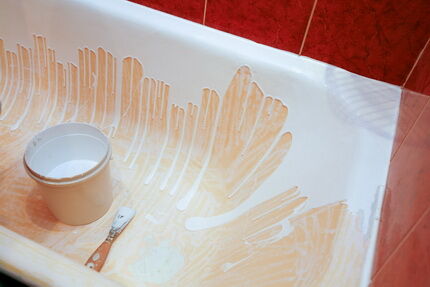
A bathtub restored in this way obtains the attractive properties characteristic of equipment with an acrylic liner. It also retains heat well, is durable, shock-resistant and easy to maintain.A self-leveling bathtub compares favorably with equipment restored by cold enamel with a perfectly flat surface, since acrylic is laid in a thicker layer.
The pouring method can be used for bowls of any shape, which cannot be said about acrylic liners, the range of which is limited to several models. The service life of products after restoration is about 15 years.
A significant disadvantage of liquid acrylic is its long drying time, which takes from 1 to 4 days. In addition, nothing should get on the acrylic surface during the drying process. Even a falling drop of water will leave a permanent mark.
You can read about how to choose self-leveling acrylic for a bathtub. this material.
Instructions for applying liquid acrylic
The preparatory work in this case will be similar to preparing a bathtub for cold enameling. At the end, be sure to remove the strapping and place a container under the drain hole into which excess acrylic will drain.The composition is prepared for work strictly according to the instructions.
If it is assumed that the bath will not be white, but colored, add tinting paste to the glass and mix well.
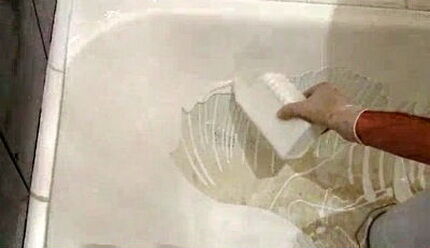
The finished mixture is poured into a small container and started to work. Acrylic is poured in a thin strip onto the side of the bathtub and pushed with a spatula under the edge of the tile. The composition is poured in a moderate stream so that the thickness of the filling layer is about 4-6 mm. The glass should flow down to about the middle of the bowl. A stream of solution is slowly moved along the sides of the bath until the circle is closed.
Masters recommend not taking long breaks and working quickly enough. After the first circle is completed, the acrylic is poured from the middle of the bowl. Moving in a spiral, they gradually cover the entire surface of the bath.
Excess composition flows into the drain hole. Any swelling that has appeared should not be touched. When dry, they will straighten on their own. At the end of the work, the bath is left until the coating is completely dry. Detailed instructions for restoration with liquid acrylic can be read in this article.
Conclusions and useful video on the topic
The videos below discuss in detail different methods of restoring a cast iron bathtub.
How to properly install an acrylic liner:
Restoration of a bathtub using the pouring method:
Cold enamel bowl:
A cast iron bathtub that has lost its attractive appearance can be “brought back to life.” This will cost much less than dismantling old equipment and installing new equipment. You need to choose one of three restoration methods and, strictly following the instructions, carry out all the work.The updated bathtub will delight you with its whiteness and will last quite a long time, and when it becomes unusable again, the procedure can be repeated.
Do you have any questions about the topic of this article? Or maybe you have ever restored a cast iron bathtub yourself? Please tell our readers which restoration method you chose, are you satisfied with the result? Leave your comments, upload photos, share your experience in the block below.
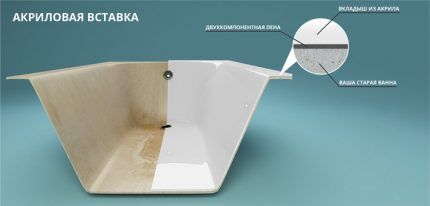




The easiest way for me to update an old cast iron bathtub turned out to be cold enameling. I couldn't find an acrylic liner of the right size. I didn’t use liquid acrylic for fear that I wouldn’t get a nice, uniform coating. I restored it using a spray gun and Reaflex 50 enamel. Everything turned out great and quickly. Only the preparation process itself is very labor-intensive; while I tore off the old enamel, degreased it, covered with film everything that didn’t need to be painted, I was exhausted. And it took a long time to dry. It's good that it was summer, and there is a summer shower. But the bathtub is like new.
In my grandmother’s old apartment, the bathtub fell into disrepair, and we did not yet know about the existence of acrylic liners. Or maybe they weren’t there then, so they cleaned them as best they could using sandpaper and chemicals. Treated, degreased and painted with regular enamel. After some time, an acrylic liner was installed. Grandma is very happy, the water is now cooling more slowly.